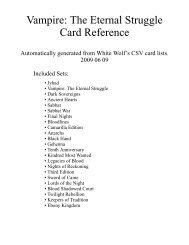Gentle Joseki.pdf - Computer Science Club
Gentle Joseki.pdf - Computer Science Club
Gentle Joseki.pdf - Computer Science Club
You also want an ePaper? Increase the reach of your titles
YUMPU automatically turns print PDFs into web optimized ePapers that Google loves.
Diagram 7<br />
The dias 6 and 7 showed 2 alternative ways of playing instead of guarding the corner as in dia 5.<br />
This brings me back to the comment of last time: (dia 5)<br />
"Instead of black 3, later on in the game black might want to play a pincer somewhere around<br />
white 4 judging from the whole board position."<br />
This is all very nice but what prevents the white player from thwarting black's intention of<br />
waiting to see what the best play will be and occupying the 3-3 point with his next move<br />
himself? Well nothing, actually.<br />
In dia 8 black did not answer white 1 but played elsewhere instead.<br />
White plays 3 and effectively takes over the corner territory. When<br />
seeing this result for the first time one is tempted to think that this is a<br />
clear disaster for black and that nothing can justify taking such a loss<br />
in the corner.<br />
A lot, of course, depends on precisely how big a move played when<br />
ignoring white 1. To judge dia 8 correctly it is further necessary to<br />
know what is at the left side of the board.<br />
Diagram 8<br />
In dia 9 a situation is shown where it<br />
was almost certainly not a good idea<br />
to ignore white's marked move. After<br />
white takes the key-point in the<br />
corner with 1 the black stones have<br />
no room to make a two-space<br />
extension towards the left and black<br />
cannot expect to make two eyes<br />
locally. Black's stone are afloat and<br />
his stones will most likely keep<br />
bothering him until the finally can get<br />
two eyes somewhere.<br />
Diagram 9<br />
Looking at dia 8 and 9 you easily can get the feeling that black never should ignore white's slide!<br />
(conveniently forgetting about the value of black's tenuki). For professionals there is, however,<br />
still another reason why dia 8 is not such a terrible result for black.<br />
Suppose white has played first in the corner at the 3-3 point.<br />
Next black has played an approach move at 1 after which<br />
white extends to 2. Well, so far so good, but...<br />
Diagram 10









